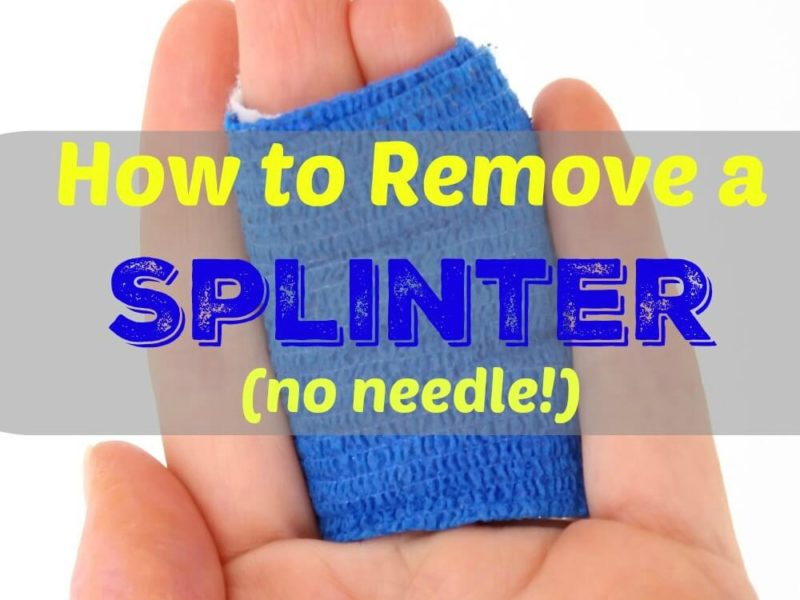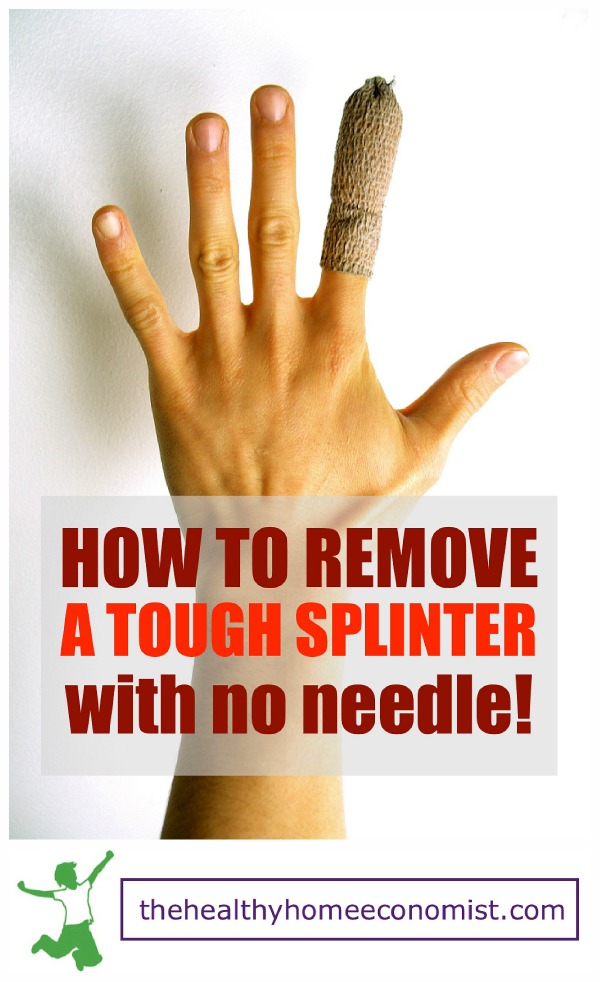How to quickly draw out even deep splinters without a needle, pain, or trip to the doctor even if they have been embedded for some time. One minute video demonstration included.

A splinter is a fragment of any foreign object that penetrates and becomes lodged inside one’s body. While splinters can come from a variety of materials such as glass, plastic, metal or even the spines of animals, for most people, splinters commonly occur on the fingers and hands from handling some type of plant matter such as a piece of wood.
When one experiences a splinter, pain as the sharp object initially penetrates the skin is usually felt. This is because the object has cut through the cutaneous layer of skin, settling into the subcutaneous layer below. While some splinters stay put at that point, most others will continue to move around, damaging additional tissue in the process.
Splinters that become lodged in the fingers or hand as would happen while doing yard work are usually very easy to remove with a simple needle that has been properly cleaned with alcohol first.
The Problem with Removing Splinters with Needles
The problem with this approach is that children don’t like it as picking at a splinter with a pointy object can sometimes hurt until part of the splinter is exposed and the rest pulled out with a pair of tweezers or a piece of tape.
The second problem with the needle approach is that it doesn’t always work if the splinter is very deep or quite thin and hard to see.
This happened to my husband recently when he got a thorn that was about an inch long deeply lodged in his left index finger while doing some yard work.
No matter how hard he tried to dig that thorn out with the traditional needle approach, he could not even find it let alone remove it.
It was just too deep.
At first, he figured the splinter would naturally work its way out. Splinters sometimes do this – the skin “pushes” them to the surface of the skin where they are easily removed a short time later with tweezers or your fingers.
That didn’t happen with this splinter. Waiting a few days made the situation much worse as the finger got very sore and began to swell.
Going to a Doctor Instead is Expensive
I became very concerned at that point because the finger was obviously infected. I suggested a trip to the doctor, but my husband wasn’t keen on that idea as the (out of network) holistic family doctor we called said it would cost $500 for the office required consultation and subsequent removal of the splinter.
$500 to remove a splinter? Unbelievable!
My husband then had the bright idea to ask his friend who is a veterinarian about the situation.
How to Remove a Splinter at Home with No Needles
The veterinarian said that removing even a deep splinter is easy with magnesium sulfate, better known as Epsom salts. Many people are familiar with an Epsom salt bath for sore muscles or to improve sleep.
This remedy uses Epsom salt in another hugely beneficial way – to draw toxins even a splinter right out of the skin. (1)
The veterinarian said you could either soak the finger a few times a day in a cup of warm water and Epsom salts or make a poultice with it. The poultice is much faster and more effective, however.
Such a method is supported in the scientific literature and very safe as well. (2)
Epsom Salts – How to Draw Out a Splinter
My husband decided to go with the poultice route. He took a small pinch of Epsom salts, placed it on the bandage section of a regular, large band-aid and wrapped the finger with it. He changed the bandage once a day or after it got wet in the shower.
Another option is to put a bit of magnesium sulfate paste (which costs just a few dollars) on the area and cover with a bandage. Magnesium sulfate is the same thing as Epsom salt.
This one minute video demonstrates the easy process. Be sure to clean the area well and use established first aid methods before and after the splinter is out of the skin. (3)
How Long Does it Take?
Within 2 days, it was apparent that the Epsom salts poultice had worked! The end of that thorn was ever so slightly sticking through the skin!
My husband pulled about 1/3″ of thorn out, but he could tell there was still more in there.
He continued to apply the Epsom salts poultice for one more day which caused the rest of the thorn to come to the surface of the skin as well. He used tweezers to pull the rest of the thorn out, which turned out to be about another 1/2″ in length.
Best of all, the swelling and soreness of the finger quickly resolved with the removal of the thorn. It has been a couple of months since this happened and the finger is perfectly fine.
Keep Magnesium Sulfate on Hand
I will be using the Epsom salts or magnesium sulfate paste on a bandage approach to remove all splinters that occur in our household from now on. I’ve purchased a small bottle of the magnesium sulfate paste, and it is now a permanent part of my medicine cabinet.
This approach suggested by our veterinary friend is far easier than using needles or enduring the drama of a doctor’s visit and there is surprisingly no pain at all involved.
One word of caution. If you choose to use the crystals instead of the paste, be sure to buy Epsom salts that are human-grade, rather than agricultural grade.
References
(1) Magnesium Sulfate Paste
(2) Use of Epsom Salts, historically considered
(3) Foreign object in the skin: First aid









If there’s a little bit of the splinter sticking out but you just can’t pull it out because of the swelling, try icing the area where the splinter went in. Sometimes that reduces the swelling and inflammation enough to let you pull it out easily with tweezers.
Thank-you, Sarah. This is good to know. Plantain also pulls things out. My herbalist mentioned it, and, when I researched in my herbalism books, one stated it works so well that it can pull out infections from teeth and tooth roots, where even antibiotics can’t always reach. Plantain is a very useful “weed” growing in most people’s yards. I infuse it into oil and make tinctures with it. However, if I’m ever out of those here in the snowy northern winter, it’s good to know there’s another great alternative. 🙂
when I was a kid a Doctor at Duke told my mom about using a bread poultice to draw out splinters & it always worked!
Thank you Sarah!
thanks for this valuable information. my children often have splinters and really don’t like me taking them out with a needle. i’ll be trying this out next time.
Nathan B, what is PRID?
I have a son that had 2 ingrown hangnails removed last year from his big toes. He now has another one ingrowing because he cut his nails wrong and too short. Would Mg Sulfate work on this? I have him soaking his toe, but it is turning red and looking infected.
Thanks a bunch!
What I’ve used for ingrown toenails in the past is tea tree oil. For me, it took the pain away almost immediately and the redness & swelling in a day or two.
Soaking in warm epsom salts definately works. When I was in college I had a really bad infected ingrown toenail. The doctor sent me home and advised to soak it in the epsom salts. This did the trick within a few days. It totally eliminated the infection and thus eliminated the pain.
Oops typo….Definitely I meant:)
Soaking the foot in warm Epsom salts water for 20 minutes will cure an infected toenail in 24 hours. No surgery, or antibiotics needed.
I would soak any infected wound with hydrogen peroxide. Thirty minutes at a time, 2 or 3 times a day until the redness is gone. It will fizz when it’s working, and may sting, but it works like a charm.
You must be careful using peroxide on open wounds because the peroxide can cause further tissue damage especially if used full strength.
Very good information. I’m going to keep this written down in my notes on Survival. I may need to know it then.
I found a way to remove metal shavings in your skin. If you can’t see the little splinter then rub it with a piece of emory cloth (used for sanding or buffing metal). It works surprisingly well.
Sarah, where did you purchase your paste? Did you have to get it from the UK or did you find a local source? I have a rose thorn in my arm that I can’t get out and would love to try this today!
Amazon shipped in from the UK was the only place I could find (click link in post above).
You can get epsom salt paste at farm supply stores as well. I use it as a poultice when my horse has a hoof abcess. Great stuff.
Hi Sarah, how can i use the epsom salt as a poultice? My 3 yr old little girl has a small splinter in her finger, she screams if i even touch her finger so i guess the needle & tweezers option is out. How can i make the poiltice? Do i simply add water to the empsom salt?
I would recommend the epsom salt paste as suggested in the article.
Decades ago my Dad suffered a badly injured arm in a truck accident. After he returned home from the hospital he soaked his arm in a special-made tub filled with epsom salt water. Little chips/splinters of bone worked their way out of the skin.
We have used ichthammol ointment for splinters very successfully. Also, living on the Gulf Coast, we have had our share of staph infections (hands, legs and feet) and it works like a charm.
Thank you for all this useful information! You certainly do have quite a few ways! I got a splinter this morning, and it was very big! We tried to get it out with only tweezers, but silly me! I thought it was a cut and rubbed it, without looking ????. My friend got a needle from my sewing box, and came straight back down with one. It was hurting like crazy, and we didn’t have alchohol to wash it with, besides, we hadn’t heard of that method. After about what seemed like 10 minutes of excruciating pain (but it was probably only 1 minute!) we got it out. It is a bit lumpy and there is a faint whitish, or brownish, (I can’t really tell) line where it was. Is this bad? Can someone please reply, ASAP! Thank you,
Amelia